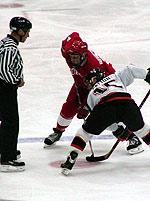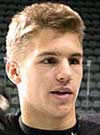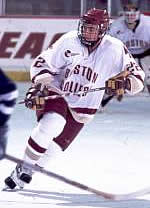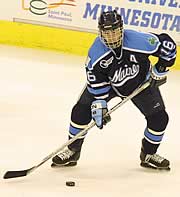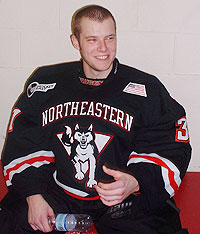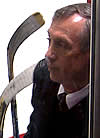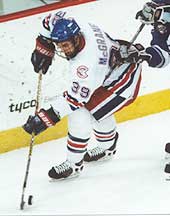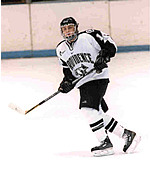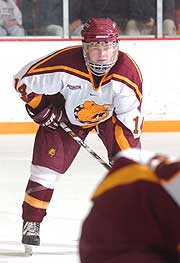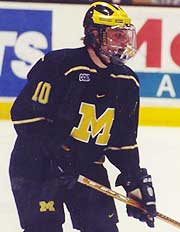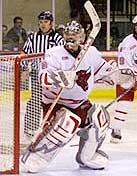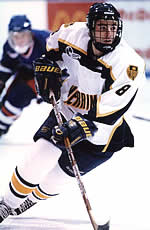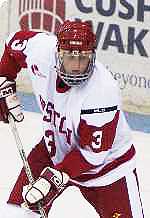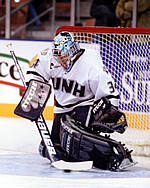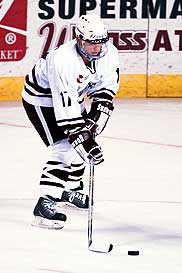Now On Tour
The WCHA’s supervisor of officials, with help from a few of his referees, is canvassing the league from Alaska to Michigan, discussing and dissecting the rule most likely to change how college hockey runs this season.
Call it the Greg Shepherd faceoff education tour. At least he has more than 15 seconds to explain it to teams at each stop.
That’s all the players will have between whistles this season under an NCAA rule that draws off the popularity of the quick faceoffs at last winter’s Olympics in Salt Lake City.
An adjustment? Yes. Impossible? No. Matching lines, however, may be the casualty of the speed, taking away some of the home-ice advantage. The age-old coaches’ trick of slowing things down between whistles when protecting a lead might be gone, too.
Like it or not — and, at least on the outside, most coaches appear to like it — it’s here.
Unnecessary? Maybe.
One of the stats the NHL is thrilled to throw out is the fact that under a similar system this preseason, average game times were down from 2:33 last season to between 2:15 and 2:18.
The average length of a WCHA game last season was 2:20. Last Saturday, Michigan Tech and Northern Michigan played a game in 2:09.
Complaints about the excessive length of college hockey games are rare. But, the way Shepherd is presenting it, this is as much about keeping the game moving as cutting down its overall time.
“If you watch some teams, the centers would kind of [mess] around, the teams would hold their players at the bench and the referees would have to go get them and tell them to get out there,” Shepherd said. “This eliminates all the [BS]. They’re going to be there, otherwise the puck is going down, otherwise they’ll get a warning and the next time’s a penalty.”
Said Denver coach George Gwozdecky: “I think everybody, whether it’s fans or whoever you like, likes to have continual action. Not that we haven’t had it before at the college level, but I think everybody agrees if we can keep the games going, as opposed to slowing them down, I think that’s a positive.”
Here’s how it’ll work. When the whistle blows to stop play, the referee gets into position for the next play. When he’s ready, he’ll start counting to five seconds, giving the visiting team the opportunity to make its line changes.
After five seconds, the referee’s hand goes up to signal it’s the home team’s turn to change. After counting to five again, he’ll signal to the assistant referee at the faceoff dot, who blows his whistle to get the centers ready for the draw.
If they’re ready before the assistant referee gets to five, the puck drops early — that’s been the case nine times out of 10 so far, Shepherd said. If someone’s not ready and the AR finishes the count, the puck drops anyway.
Meanwhile, the assistant referees are just as busy as the players. They have to collect the puck and get in position within a few seconds. That can be tricky, especially when the play moves to the other end of the ice after an icing call.
The down time will be a little longer after goals and penalties, but for the most part, there shouldn’t be more than 15 seconds between plays.
There have been some quirks in trial runs during exhibition and intrasquad games this season. Denver coach George Gwozdecky said the explanation of penalties, normally given to coaches after multiple players go to the penalty box, was overlooked to get to the faceoff.
“I think the officials were so intent on getting the puck down that they probably forgot to take a little extra time to inform the coaches of what the situation was,” Gwozdecky said.
Shepherd insists he has covered all the bases as far as instructing the officials on the new procedure, and his trip around the league is designed to give the teams more knowledge on the subject.
The new rule will require coaches to make quicker decisions on lines and players to make sure they don’t get burned by not being ready for the draw.
“Once you make the decision and holler out who’s going, the guys have got to be ready to get to the faceoff circle,” Alaska-Anchorage coach John Hill said. “You don’t have time to stand around and talk about setting something up if you’re trying to work a play in the offensive zone.”
Now, we wait for the first team to get stung by being slow between the whistles and await the reaction.
Opposite Ends
The coaching dynamic at the Ice Breaker Invitational is fascinating. Wisconsin’s Mike Eaves and Northern Michigan’s Walt Kyle are will be coaching games Nos. 1 and 2, respectively, in their Division I collegiate careers Friday night at the Kohl Center.
They’ll be going up against Dan Fridgen, in his ninth season and in game 289, and Jack Parker, in season No. 30 and game 1,045.
They’re at opposite ends of the spectrum, and Eaves looks forward to meeting up with Parker in particular, one of college hockey’s best storytellers.
“He’s one of those guys in hockey, he’s seen a lot in 30 years,” Eaves said. “He’s got more stories than Carter’s got pills. He’s such a good man. You listen to him tell stories, not only has he seen a lot but he can weave a pretty good tale as well, so it makes it twice as enjoyable.”
As Eaves prepares to debut behind the Kohl Center bench, he said he’s not nervous. But putting a raw team out on the ice, one in the middle of a transformation, could be cause for some butterflies.
“There’s going to be excitement because we’re going to have maybe close to 10,000 people here,” Eaves said. “But we’ve got a lot of work to do. There’s no grand illusions here — we’re at a crawling phase right now. We’re learning things step by step, inch by inch right now.
“The kids are going to be excited, but for a lot of these kids, doing what we’re doing is going to take them back a step. We’re going to take one step back to take three or four steps forward. Whenever you learn something new, that’s what happens because you’re trying to think and you’re trying to work hard at the same time and as a result your performance usually dips.”
Oh, and don’t mind the Badgers if they drop and do push-ups every time a whistle blows. After a few days in Camp Eaves, that might be the conditioned response.
Eaves has closed the first days of practice to the media and the public, and in the closed sessions the UW players have paid for mistakes with push-ups.
“We’re just trying to change habits, trying to bring what we’re doing to the front of their brain so they’re very aware of it,” Eaves said. “Because only when you have awareness can you have change. So, sometimes by doing something that’s out of the ordinary like stopping practice, dropping down and giving push-ups, it’s like, ‘Gee, this guy’s serious. They’re holding us accountable. I don’t want to do any push-ups here, I’m going to do it right.'”
That kind of discipline factor would seem welcome to a team that led the league in penalty minutes last season, by more than two minutes per game over the closest competitor.
Start Strong Or Don’t Start At All
Not many teams have the chance to take direct action on two of their goals in the first two weekends of the regular season. Goals, however, are a bit different at Alaska-Anchorage than they are at, say, Minnesota and Denver.
The Seawolves have a late-season goal, too — becoming the first UAA team to get to the Final Five. But they’re faced with a series with in-state rival Alaska-Fairbanks and their Nye Frontier Classic tournament before the season really even gets rolling.
It just so happens that those two events are central to the Seawolves’ objectives for the season. They set claiming the Alaska Airlines Governor’s Cup, as the winner of the season series with Fairbanks, and winning their tournament as two of the three things they’ll shoot for. The first of two series with the Nanooks is this weekend in Anchorage and the Seawolves get Iona and Maine next weekend in the Classic.
“I guess in a perfect world you’d play these games later in the season, but it’s also a very exciting way to start off the season,” Hill said. “Our nonconference games are important — all six. Sometimes, I guess, sure, you would prefer to maybe not have so much at stake when you play them. But at the same time, I think it’s great that there’s a lot at stake.”
Hill will have a good read on his team in two weeks’ time, but, if things don’t go his way, part of that read could be that one of the goals is past and another is nearly out of reach.
If the Nanooks win both games this weekend, the Seawolves would have to win both games in Fairbanks on the weekend of March 7 and 8 just to force a shootout on road ice.
Possibly worse yet, they’ll have to contend with defending national runner-up Maine in the Classic next Saturday. Last season, they took three points in their tournament but watched Denver skate away with the trophy after Denver won twice.
So the Seawolves have to be somewhat cautious of putting all their proverbial eggs in the basket of the first two weekends. Playing well and living with the results is the plan.
“I don’t think you want to make the results the end-all, be-all,” Hill said. “But at the same time, you can’t be afraid to state what your goals are. And ours are to win the Governor’s Cup, win our tournament and make it to the Final Five in the WCHA.
“And if you don’t achieve it, it doesn’t mean you’ve failed or the season hasn’t been a success. But those are the rewards that are out there for us, and we’re striving to reach those.”
Missing You
If you’re a fan of goaltenders in the WCHA — and who isn’t, really? — the 1999-2000 season was about as good as it could get.
Think about it: You had Karl Goehring and Andy Kollar in charge at North Dakota, you had Graham Melanson in one of his best seasons at Wisconsin, you had Scott Meyer and Dean Weasler battling for time at St. Cloud State.
You had a tandem of Jeff Sanger and Colin Zulianello at CC; an Eric Pateman in the best shape of his career at Minnesota State-Mankato; a kid named Adam Hauser with the Gophers; a wall in Duluth’s Brant Nicklin; a solid Stephen Wagner at Denver; and a freshman named Wade Dubielewicz also with the Pioneers.
Not too shabby. Hope you enjoyed it then.
There are some top-notch goaltenders in the WCHA today — unquestionably led by Dubielewicz — but this group isn’t full of household names.
“I remember three or four years ago, where eight or nine teams had very high-end goaltenders,” Minnesota-Duluth coach Scott Sandelin said. “Now, I think there’s some good goalies, but who’s going to emerge?”
That’s the dilemma for a number of league teams this season. Denver has it made with Dubielewicz and Adam Berkhoel. Wisconsin has a dependable tandem of Scott Kabotoff and Bernd Bruckler.
But the eight other teams have at least some questions about their goaltending. Will Chris King or Kevin Reiter step forward to take the top spot at UAA? Can Curtis McElhinney stabilize CC’s defense the way Sanger did? Is Cam Ellsworth the answer for an entire season at Michigan Tech?
Will uncertainty between Travis Weber and Justin Johnson be one of Minnesota’s downfalls? Will UMD’s Rob Anderson be able to be an every-game goalie? Can Mankato’s goalies stay healthy?
Will North Dakota find quality or mediocrity between the pipes? And will Jake Moreland be able to lift himself to the level of Meyer and Weasler?
You’d be safe in assuming there will be some surprises in the goaltending ranks this season — some good, some bad.
In particular, keep an eye on the North Dakota situation. Josh Siembida and Jake Brandt had sub-par seasons a year ago — at least when held against the example of Goehring, one of the WCHA’s top 50 players of its 50-year history as chosen last season.
It looks like the Sioux forwards are ready to take off and the defense could be improved. But they need the goaltenders to follow suit for the team to climb the standings.
On The Move
For the fourth straight season, the WCHA has at least one new coach in its ranks. Wisconsin’s Eaves is the first coach to be hired by a league team from outside the 10-team circle since Scott Owens left the United States Hockey League to take over for Don Lucia at Colorado College in 1999.
Eaves’ may be the most prominent move of the summer, but that was just one of many changes.
The league has two new athletics directors: Joel Maturi at Minnesota and Kevin Buisman at Minnesota State. Maturi, the former AD at Miami and an assistant AD at Wisconsin, long has been a supporter of college hockey.
Three schools have new assistant coaches. With Mark Strobel leaving Minnesota-Duluth for Nebraska-Omaha, Lee Davidson moved to the Bulldogs from a volunteer position at North Dakota. Former UMD goaltender Taras Lendzyk joined his alma mater as a volunteer goalie coach.
Doc DelCastillo left St. Cloud State, also to go to UNO, and was replaced by Fred Harbinson, a former assistant for Sioux City of the USHL.
Eaves’ staff at Wisconsin includes Troy Ward and John Hynes. Hynes followed Eaves from the USA Hockey National Team Development Program; Ward was in management with the East Coast Hockey League.
As for the former Badgers assistants, Mark Johnson is the women’s coach at UW and Pat Ford took an assistant job at Findlay.
On The Shelf
He missed much of training camp and isn’t to the conditioning level of his teammates, Eaves said, so his fitness to play on Saturday will be evaluated after Friday’s game. Boeser has played in 80 straight games for UW and his goal after revealing his illness to the public was not to miss a game.
The original prognosis on Steward, a top-line forward, was that he’d be out three to six weeks. Steward was scheduled to be re-evaluated on Thursday.
It’ll take six weeks for the broken bone in Dahl’s hand to heal, but Hill said the sophomore forward would be fitted with a playing splint as soon as the pain subsides.
The injuries will test the Seawolves’ newfound depth. Martin Stuchlik joined Vladimir Novak and Peter Chytka, making an all-Czech Republic top line. The so-called Energy Line will feature Jace Digel, Spencer Carbery and Justin Johnson on Friday, but Hill might call on that depth if a change is needed for Saturday’s game.
New In Stripes
The WCHA has four new referees this season, but one is already familiar to the league.
Marco Hunt, a WCHA assistant referee for games in Minnesota, got his orange armbands from Shepherd in the offseason. Also new are Todd Anderson, Brad Albers and Craig Hanson.
League refs John Boche and Mike Riley retired in the summer. The new hires bring the referee roster to 13 members, including Shepherd, who now takes the ice mainly in emergency situations.
Shepherd said he brought in four referees to replace two so the newcomers could get their feet wet slowly and not be immediately called into action every weekend. The second half of the season, he said, is when the officials who have done the best job will get the most calls.
Anderson will make his league debut next week at Wisconsin’s nonconference series with Alabama-Huntsville in Madison.
The Kinks, And Not The “Lola” Kind
No. 2 Denver vs. No. 7 Michigan State: Not bad for the first full weekend of the college hockey season.
But don’t fool yourself into thinking Friday’s national spotlight game will be an instant classic. Not in the first game of the season, anyway.
This will most likely end up looking like … well, a first game of the season. It’ll probably be sloppy, there will be a few defensive breakdowns and not everyone will be on the same page.
Gwozdecky and the Pioneers are anticipating an “adjustment period” before they’ll be at top form, and they’re not sure how long that will be. It might be a period on Friday against the Spartans; it might be the whole weekend at the Maverick Stampede in Omaha, Neb.; it might continue through Monday’s exhibition game against Windsor.
It’s the same thing with every WCHA team. Everyone has some bugs to work out at the start of the season. The early advantage, however, goes to the team that works them out the fastest.
The Pioneers make Boston College their second top-10 opponent of the season next Friday, so they’ll need to look sharp early.
“We haven’t had the opportunity to play against anybody but ourselves, whereas Michigan State has played a couple of games,” Gwozdecky said, referencing the Spartans’ exhibition victories over the U.S. Under-18 team and Western Ontario.
“That definitely helps your timing and it definitely helps your rhythm. I know it really helps the freshmen, who need some time to adjust. There’s going to be an adjustment period in that game on Friday and perhaps that game on Saturday as well.”
The key date to remember for the Pioneers is Nov. 1, when they open the WCHA season at Wisconsin. If they’re not in good form by then, you’ll hear concerns.

